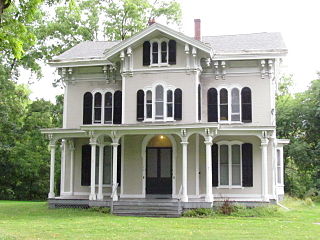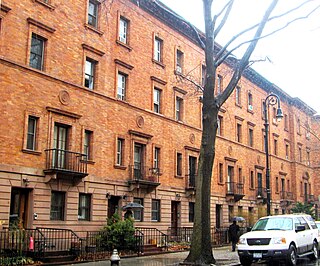
The Vassar College Observatory is an astronomical observatory of the private Vassar College, located near the eastern edge of the Poughkeepsie, New York college's campus. Finished in 1865, it was the first building on the college's campus, older even than the Main Building, with which it shares the status of National Historic Landmark. The observatory's significance is due to its association with Maria Mitchell, the first widely known woman astronomer in the United States.

The Main Building of Vassar College is the oldest surviving building on its campus in Poughkeepsie, New York, and the center of academic life. It was built by James Renwick, Jr. in the Second Empire style in 1861, the second building in the history of what was one of America's first women's colleges. It is one of the earliest, largest, and most important examples of Second Empire architecture in the United States and is a National Historic Landmark for its architecture and educational significance. At the time of its completion, the structure contained the most interior space of any building in the United States, and housed the entire college, including dormitories, libraries, classrooms, and dining halls. Currently, the first and second floors house campus administration while the remaining three house student rooms.

Springside was the estate of Matthew Vassar in Poughkeepsie, New York, United States. It is located on Academy Street just off US 9. Detailed plans for a landscape and complex of farm buildings were drawn up by the influential Andrew Jackson Downing prior to his death. The landscaping was completed and remains Downing's only surviving work, but only a few of the buildings were ever built and most have since been lost to fire and structural failure. A cottage where Vassar resided, Downing's only known surviving building, had to be dismantled and removed in the mid-1970s. Its facade is on display in the New York State Museum.

New Dayton is a hamlet in southern Alberta, Canada within the County of Warner No. 5. It is located on Highway 4 between the villages of Stirling and Warner, approximately 48 kilometres (30 mi) southeast of Lethbridge. New Dayton was named for their former home by settlers from Dayton, Ohio.

The Farmer's and Manufacturer's Bank building is located at the corner of Market and Cannon Streets in downtown Poughkeepsie, New York, United States, near the Bardavon and across from the Dutchess County Court House and Old Poughkeepsie YMCA. It is one of only two non-residential Greek Revival buildings remaining in the city.

The Mill Street–North Clover Street Historic District is located along those streets and Main Street in western Poughkeepsie, New York, United States. It is an irregularly-shaped area of 27 acres (11 ha) between US 9 and downtown Poughkeepsie, located on the slope up from the Hudson River. There are roughly 139 historic buildings, and very few new ones.

The Vassar Institute building is located at Main and Vassar streets in Poughkeepsie, New York, United States, across from the architecturally similar Vassar Home for Aged Men. It is a late-19th century building combining the Italianate, Victorian Gothic and Second Empire architectural styles.

The former Vassar Home for Aged Men is located at Main and Vassar streets in Poughkeepsie, New York, United States. It is just across the street from the architecturally similar Vassar Institute, and both buildings are credited to architect J.A. Wood. In the 1970s it became the Cunneen-Hackett Arts Center.

The Second Baptist Church in Poughkeepsie, New York, United States, is located at the corner of Vassar and Mill streets. It is a wooden building from the late 1830s in the Greek Revival architectural style, the only remaining church in the city in that style.

There are 69 properties listed on the National Register of Historic Places in Albany, New York, United States. Six are additionally designated as National Historic Landmarks (NHLs), the most of any city in the state after New York City. Another 14 are historic districts, for which 20 of the listings are also contributing properties. Two properties, both buildings, that had been listed in the past but have since been demolished have been delisted; one building that is also no longer extant remains listed.

Payne Cobblestone House is a historic home located at Conesus in Livingston County, New York. It was constructed in the 1830s and is a vernacular 1-story, five-by-three-bay cobblestone structure with a 1 1⁄2-story offset frame wing. The interior features some Greek Revival style details. It features medium-sized field cobbles set in horizontal rows in its construction. Also on the property are three contributing structures: a sandstone railroad embankment and culvert built about 1853 and a small barrel vault culvert built to accommodate a small stream.

Rowe House is a historic home located at Wayland in Steuben County, New York. It is a large three-by-seven-bay Tudor Revival– style residential building with an attached 1-story, three-bay garage wing at the rear. It was designed in 1926 by noted Rochester architect J. Foster Warner.

Bute–Warner–Truax Farm is a historic farm complex and national historic district located at Charlotteville in Schoharie County, New York. The district includes three contributing buildings, one contributing site, and two contributing structures. It includes a Greek Revival style farmhouse built about 1853. Also included is a milk house, auto garage, fire pond, and 19th-century family burial plot.

Samuel Adams Warner House is a historic home located at Roslyn in Nassau County, New York. It was designed by architect Samuel Adams Warner and built about 1875 and is a 1 1⁄2-story, vernacular Swiss chalet–style frame dwelling on a partially excavated stone basement. It features a broad, overhanging gable roof with jerkin heads. An L-shaped gallery projects from the south and west sides, and the gallery deck is embellished by scroll-sawn fascia.

Rombout House is a historic home located at Poughkeepsie, Dutchess County, New York. It was built about 1854 on land that had been part of the original British royal Rombout Patent of 1685 and is a 2 1⁄2-story, three-bay-wide, Hudson River Bracketed architectural style dwelling. It sits on a raised basement and features a central pavilion. It has been owned by Vassar College since 1915.
Warner House may refer to:

The St. Nicholas Historic District, known colloquially as "Striver's Row", is a historic district located on both sides of West 138th and West 139th Streets between Adam Clayton Powell Jr. Boulevard and Frederick Douglass Boulevard in the Harlem neighborhood of Manhattan, New York City. It is both a national and a New York City district, and consists of row houses and associated buildings designed by three architectural firms and built in 1891–93 by developer David H. King, Jr. These are collectively recognized as gems of New York City architecture, and "an outstanding example of late 19th-century urban design":

Linden–South Historic District is a national historic district located in the South Wedge neighborhood of Rochester in Monroe County, New York. The district consists of 136 contributing buildings, including 82 residential buildings, 53 outbuildings, and one church. The houses were constructed between 1872 and 1913 in a variety of vernacular interpretations of popular architectural styles including Gothic Revival, Italianate, Queen Anne, and Colonial Revival styles. The houses are 2 1/2-stories, are of frame or brick construction, and were designed by local architects employed by the developer Ellwanger & Barry. Among the more prominent are Andrew Jackson Warner and Claude Bragdon. The church is the former South Avenue Baptist Church, now Holy Spirit Greek Orthodox Church, built in 1909–1910 in a Late Gothic Revival style. Also in the district is a three-story, Queen Anne style mixed use building, with commercial space on the first floor and residential units above, located at 785 South Avenue.

Glenays, also known as Leighton House, is a historic home located in Radnor Township, Delaware County, Pennsylvania, with a Bryn Mawr postal address, but not in the census-designated place. The property was purchased by Richard Roger Montgomery and his wife Elisabeth Binney Montgomery in 1859. It is a three-story, stucco over stone Italian Villa style dwelling built in three sections. The first section was built in 1859, with additions built in the late-19th century and 1925. The 1925 addition and garden walls (1928) were designed by architect George Howe (1886–1955).






















